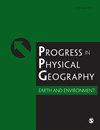Automatic recognition of active landslides by surface deformation and deep learning
IF 3.6
3区 地球科学
Q2 GEOGRAPHY, PHYSICAL
Progress in Physical Geography-Earth and Environment
Pub Date : 2024-08-24
DOI:10.1177/03091333241276523
引用次数: 0
Abstract
Catastrophic landslides are generally evolved from potential active landslides, and early identification of active landslides over an extensive region is vital to effective prevention and control of disastrous landslides in urban areas. Interferometric Synthetic Aperture Radar (InSAR) has immense potential in mapping active landslides. However, artificial interpretation of InSAR measurements and manual recognition of active landslides are very laborious and time-consuming, with a relatively high missing and false alarms. That hinders the application of InSAR technique and the identification of active landslides in wide areas. Automatic recognition of active landslides has always been a great challenge and has been relatively rarely investigated by previous studies. This work establishes comprehensive identification indices of geoenvironmental, disaster-triggering, and surface deformation features. Moreover, it suggests a novel deep learning algorithm of SDeepFM to conduct automatic identification of active landslides across a vast and landslide-serious area of Hualong County. Some new viewpoints are suggested as follows. (1) The identification indices consist of disaster-controlling, disaster-inducing, and active deformation characteristics and are constructed in terms of the cause characteristics of active landslides. Thus, it can effectively decrease the false alarms of active landslide identification. (2) The proposed SDeepFM algorithm features a spatial-perception ability and can adequately extract and fuse the low-level and high-level semantic features. It outperforms the classification and regression tree (CART), multi-layer perceptron (MLP), convolutional neural network (CNN), and deep neural network (DNN) algorithms. The test accuracy attains 0.91, 99.73%, 90.21%, 0.92, 0.96, and 0.91 in F1-score, Accuracy, Precision, Recall, AUC, and Kappa, respectively. (3) A total of 164 active landslides are exactly recognized, and 39 active landslides are newly identified in this work. (4) In Hualong County, the characteristics of slope deformation, spatial context, lithology, tectonic movement, human activity, and topography play important roles in active landslide identification. River distribution and rainfall also contribute to active landslide recognition.通过表面变形和深度学习自动识别活动滑坡
灾难性山体滑坡一般由潜在的活动山体滑坡演变而来,及早识别大范围区域内的活动山体滑坡对于有效预防和控制城市地区的灾难性山体滑坡至关重要。干涉合成孔径雷达(InSAR)在绘制活动滑坡地图方面潜力巨大。然而,对 InSAR 测量结果的人工判读和活动滑坡的人工识别非常费力和费时,而且漏报和误报率相对较高。这阻碍了 InSAR 技术的应用和大面积活动滑坡的识别。活动滑坡的自动识别一直是一个巨大的挑战,以往的研究也相对较少。这项工作建立了地质环境、灾害触发和地表变形特征的综合识别指标。此外,还提出了一种新颖的 SDeepFM 深度学习算法,用于对化隆县广阔的滑坡重灾区进行活动滑坡的自动识别。提出了以下一些新观点。(1) 根据活动性滑坡的成因特征,构建由灾害控制特征、灾害诱发特征和活动变形特征组成的识别指标。因此,可有效降低活动滑坡识别的误报率。(2) 所提出的 SDeepFM 算法具有空间感知能力,能够充分提取和融合低层次和高层次语义特征。其性能优于分类回归树(CART)、多层感知器(MLP)、卷积神经网络(CNN)和深度神经网络(DNN)算法。测试准确率在 F1-score、Accuracy、Precision、Recall、AUC 和 Kappa 方面分别达到 0.91、99.73%、90.21%、0.92、0.96 和 0.91。(3)本研究共准确识别出 164 个活动滑坡,新识别出 39 个活动滑坡。(4) 在化隆县,斜坡变形特征、空间环境、岩性、构造运动、人类活动和地形在活动滑坡识别中起着重要作用。河流分布和降雨也有助于活动滑坡的识别。
本文章由计算机程序翻译,如有差异,请以英文原文为准。
求助全文
约1分钟内获得全文
求助全文
来源期刊
CiteScore
7.20
自引率
5.10%
发文量
53
审稿时长
>12 weeks
期刊介绍:
Progress in Physical Geography is a peer-reviewed, international journal, encompassing an interdisciplinary approach incorporating the latest developments and debates within Physical Geography and interrelated fields across the Earth, Biological and Ecological System Sciences.

 求助内容:
求助内容: 应助结果提醒方式:
应助结果提醒方式:


